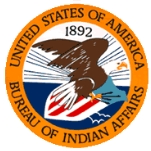The Bureau of Indian Affairs (BIA) is a federal agency within the Department of Interior. The BIA is responsible for the administration and management of 55.7 million acres of land held in trust by the United States for American Indians, Indian tribes, and Alaska Natives. Although there are 561 federally recognized tribal governments, it is the BIA that controls the development of forestlands, leasing assets on these lands, directing agricultural programs, protecting water and land rights, developing and maintaining infrastructure and economic development. The BIA also provides education services to 48,000 Native Americans.
The BIA had its beginnings in 1775 when a trio of Indian agencies were created by the Second Continental Congress to negotiate treaties with Native Americans and secure their neutrality during the American Revolutionary War. In 1789, Congress moved all Native American relations to the War Department, which had just formed that year. Today, the War Department is known as the Department of Defense. In 1806, Congress established a Superintendent of Indian Trade in the War Department whose responsibility it was to maintain the factory trading network of the fur trade. When the factory system ended, it left a hole in the network of relations between the U.S. government and Native Americans. Seeing this, then Secretary of War John C. Calhoun created the Bureau of Indian Affairs (also referred to as the Office of Indian Affairs or Indian Office until 1849), in 1824, but he did so without Congressional approval. Nonetheless, the bureau attained viability inside the Department of War and was officially transferred to the Department of the Interior in 1849.
During the 1960s and 1970s, many tribes fought to regain their rights. One result of this struggle was the institution of Indian rights organizations such as the American Indian Movement (AIM). AIM’s mission was to make the public aware of Native American civil rights violations, as well as the government’s flippancy toward Indian interests. To this end, AIM famously seized the BIA headquarters in Washington in 1972, and in 1973 became engaged in an armed standoff with the U.S. Marshals Service at Wounded Knee, South Dakota. The FBI continuously tried to stifle the activities of AIM, paying informants to report on its activities and members, as well as using various intimidation tactics including violence. Despite this, AIM continues to bring successful suit against the federal government for the protection of Native American rights.
From War to Self-Determination: A History of the Bureau of Indian Affairs (by C.L. Henson, American Studies Today)
The primary stakeholders affected by the BIA should of course be Native Americans. Unfortunately, there is a broad spectrum of those who face potential profits and losses dependant on BIA policy, and therefore seek to influence the BIA. These stakeholders include mining companies, non-Indian casinos, residents and business owners in areas of proposed Indian casinos, residents and business potentially affected by tribal recognition, and the federal government itself, among others.
|
Datacom Sciences, Inc.
|
$65,356,790
|
|
Sysco Corporation
|
$57,551,073
|
|
Arviso-Okland Construction Joint Venture
|
$49,309,728
|
|
Salt River Project Agricultural Improvement and Power District
|
$46,251,862
|
|
Groupe CGI, Inc.
|
$38,055,906
|
|
David Boland, Inc.
|
$29,626,000
|
|
Native American Services Corp.
|
$26,273,294
|
|
South Coast, Inc.
|
$22,778,108
|
|
Nana Regional Corporation, Inc.,
|
$21,495,923
|
|
Maloy Construction, Inc.
|
$21,372,109
|
Cobell Litigation
Timbisha Shoshone Death Valley Land Restoration Project (Dickshovel)
Calls for reform of the BIA have been centered on the mishandling of trust funds.
DOI Trust Reform: Trust Reform Final Report and Roadmap (PDF)
Carl J. Artman
- Table of Contents
- Overview
- History
- What it Does
- Where Does the Money Go
- Controversies
- Suggested Reforms
- Comments
- Leave a comment

Lawrence S. “Larry” Roberts, an enrolled member of the Oneida Nation of Wisconsin, became the acting assistant secretary of the Bureau of Indian Affairs (BIA) on December 10, 2015, and remained in that post until January 20, 2017, when Donald Trump was sworn in as president of the United States. Former BIA director Mike Black has stepped in to replace Roberts as acting assistant secretary until a new one is appointed by Secretary of the Interior Ryan Zinke.
Roberts earned a bachelor’s degree in political science and sociology from the University of Wisconsin in 1992, then his law degree from that school three years later.
He began his legal career as part of the Department of Justice’s honors program. He stayed there as a trial attorney in the Indian Resources Section from September 1995 until January 2002, protecting tribal treaty-reserved hunting and fishing rights. He then moved to the Environmental Protection Agency’s Office of General Counsel, assisting in the implementation of federal environmental programs by tribes.
Roberts left federal service in 2002 to go into private practice, including a stint at the Patton Boggs law firm (now Squire Patton Boggs) as a registered lobbyist, working on Indian law and environmental matters. From 2003 to 2005, served as chair of the Native American Resources Committee of the American Bar Association’s Section of Environment, Energy and Resources.
He returned to government in July 2010 as general counsel to the National Indian Gaming Commission, then joined the Department of the Interior on September 6, 2012 as deputy assistant secretary in the Bureau of Indian Affairs, a post he held for three months. In November 2012, Roberts was named principal deputy assistant secretary in the bureau. He took over as acting assistant secretary of the BIA upon the departure of Kevin Washburn in late 2015.
-Steve Straehley
To Learn More

Larry EchoHawk, President Obama’s choice to head the Bureau of Indian Affairs, was born August 2, 1948, in Cody, Wyoming. A member of the Pawnee Native American tribe of Oklahoma, he is a leading supporter of Native American rights, a Democrat, and a devout Mormon. EchoHawk is one of six children born to a mother with only an eighth grade education. All of her children attended college, four achieved graduate degrees, and three achieved law degrees.
- Latest News
- D.C. Public Schools will Teach all Second-Graders to Ride a Bike
- New Rule in Germany Limits Sales of Sex-Themed E-Books to 10pm to 6am
- What Happened to the 6-Year-Old Tibetan Boy the Chinese Government Kidnapped 20 Years Ago?
- U.S. Ambassador to Turkey Photoshops his Hair Color to Mock Turkish Mayor
- Mystery Artist Calls Attention to Unfixed Potholes by Drawing Penises around Them
The Bureau of Indian Affairs (BIA) is a federal agency within the Department of Interior. The BIA is responsible for the administration and management of 55.7 million acres of land held in trust by the United States for American Indians, Indian tribes, and Alaska Natives. Although there are 561 federally recognized tribal governments, it is the BIA that controls the development of forestlands, leasing assets on these lands, directing agricultural programs, protecting water and land rights, developing and maintaining infrastructure and economic development. The BIA also provides education services to 48,000 Native Americans.
The BIA had its beginnings in 1775 when a trio of Indian agencies were created by the Second Continental Congress to negotiate treaties with Native Americans and secure their neutrality during the American Revolutionary War. In 1789, Congress moved all Native American relations to the War Department, which had just formed that year. Today, the War Department is known as the Department of Defense. In 1806, Congress established a Superintendent of Indian Trade in the War Department whose responsibility it was to maintain the factory trading network of the fur trade. When the factory system ended, it left a hole in the network of relations between the U.S. government and Native Americans. Seeing this, then Secretary of War John C. Calhoun created the Bureau of Indian Affairs (also referred to as the Office of Indian Affairs or Indian Office until 1849), in 1824, but he did so without Congressional approval. Nonetheless, the bureau attained viability inside the Department of War and was officially transferred to the Department of the Interior in 1849.
During the 1960s and 1970s, many tribes fought to regain their rights. One result of this struggle was the institution of Indian rights organizations such as the American Indian Movement (AIM). AIM’s mission was to make the public aware of Native American civil rights violations, as well as the government’s flippancy toward Indian interests. To this end, AIM famously seized the BIA headquarters in Washington in 1972, and in 1973 became engaged in an armed standoff with the U.S. Marshals Service at Wounded Knee, South Dakota. The FBI continuously tried to stifle the activities of AIM, paying informants to report on its activities and members, as well as using various intimidation tactics including violence. Despite this, AIM continues to bring successful suit against the federal government for the protection of Native American rights.
From War to Self-Determination: A History of the Bureau of Indian Affairs (by C.L. Henson, American Studies Today)
The primary stakeholders affected by the BIA should of course be Native Americans. Unfortunately, there is a broad spectrum of those who face potential profits and losses dependant on BIA policy, and therefore seek to influence the BIA. These stakeholders include mining companies, non-Indian casinos, residents and business owners in areas of proposed Indian casinos, residents and business potentially affected by tribal recognition, and the federal government itself, among others.
|
Datacom Sciences, Inc.
|
$65,356,790
|
|
Sysco Corporation
|
$57,551,073
|
|
Arviso-Okland Construction Joint Venture
|
$49,309,728
|
|
Salt River Project Agricultural Improvement and Power District
|
$46,251,862
|
|
Groupe CGI, Inc.
|
$38,055,906
|
|
David Boland, Inc.
|
$29,626,000
|
|
Native American Services Corp.
|
$26,273,294
|
|
South Coast, Inc.
|
$22,778,108
|
|
Nana Regional Corporation, Inc.,
|
$21,495,923
|
|
Maloy Construction, Inc.
|
$21,372,109
|
Cobell Litigation
Timbisha Shoshone Death Valley Land Restoration Project (Dickshovel)
Calls for reform of the BIA have been centered on the mishandling of trust funds.
DOI Trust Reform: Trust Reform Final Report and Roadmap (PDF)
Carl J. Artman
Comments

Lawrence S. “Larry” Roberts, an enrolled member of the Oneida Nation of Wisconsin, became the acting assistant secretary of the Bureau of Indian Affairs (BIA) on December 10, 2015, and remained in that post until January 20, 2017, when Donald Trump was sworn in as president of the United States. Former BIA director Mike Black has stepped in to replace Roberts as acting assistant secretary until a new one is appointed by Secretary of the Interior Ryan Zinke.
Roberts earned a bachelor’s degree in political science and sociology from the University of Wisconsin in 1992, then his law degree from that school three years later.
He began his legal career as part of the Department of Justice’s honors program. He stayed there as a trial attorney in the Indian Resources Section from September 1995 until January 2002, protecting tribal treaty-reserved hunting and fishing rights. He then moved to the Environmental Protection Agency’s Office of General Counsel, assisting in the implementation of federal environmental programs by tribes.
Roberts left federal service in 2002 to go into private practice, including a stint at the Patton Boggs law firm (now Squire Patton Boggs) as a registered lobbyist, working on Indian law and environmental matters. From 2003 to 2005, served as chair of the Native American Resources Committee of the American Bar Association’s Section of Environment, Energy and Resources.
He returned to government in July 2010 as general counsel to the National Indian Gaming Commission, then joined the Department of the Interior on September 6, 2012 as deputy assistant secretary in the Bureau of Indian Affairs, a post he held for three months. In November 2012, Roberts was named principal deputy assistant secretary in the bureau. He took over as acting assistant secretary of the BIA upon the departure of Kevin Washburn in late 2015.
-Steve Straehley
To Learn More

Larry EchoHawk, President Obama’s choice to head the Bureau of Indian Affairs, was born August 2, 1948, in Cody, Wyoming. A member of the Pawnee Native American tribe of Oklahoma, he is a leading supporter of Native American rights, a Democrat, and a devout Mormon. EchoHawk is one of six children born to a mother with only an eighth grade education. All of her children attended college, four achieved graduate degrees, and three achieved law degrees.
- Latest News
- D.C. Public Schools will Teach all Second-Graders to Ride a Bike
- New Rule in Germany Limits Sales of Sex-Themed E-Books to 10pm to 6am
- What Happened to the 6-Year-Old Tibetan Boy the Chinese Government Kidnapped 20 Years Ago?
- U.S. Ambassador to Turkey Photoshops his Hair Color to Mock Turkish Mayor
- Mystery Artist Calls Attention to Unfixed Potholes by Drawing Penises around Them






Comments